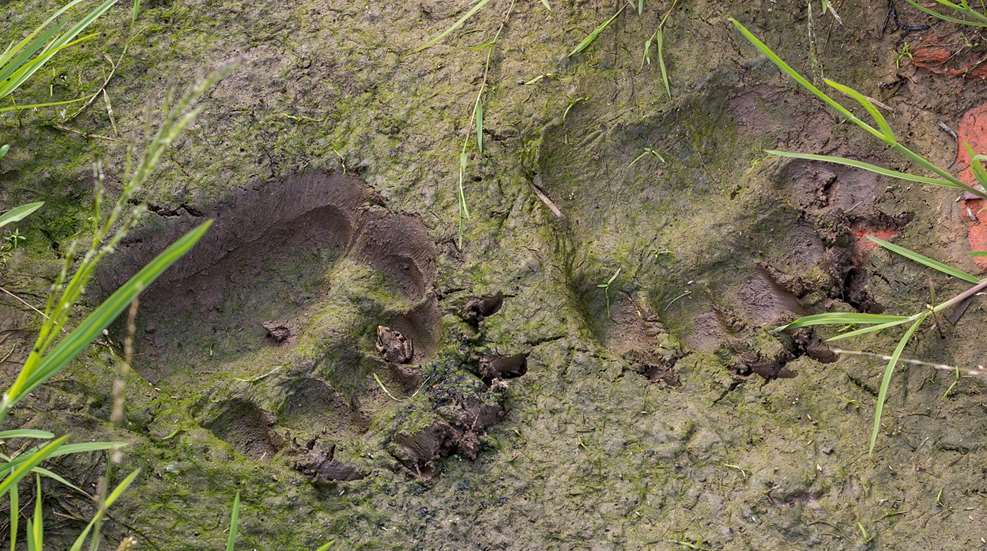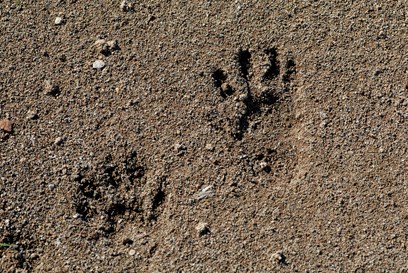
The woods offer a lot of information for anyone who pauses to take a closer look. While out on a hike you may spook the occasional deer or squirrel as you pass by, but you’re probably missing signs galore signaling the vast array of wildlife that also calls the woods home. Animals large and small are excellent at hiding, but these creatures leave behind clues as to their activities, species and more. Below, we take a closer look at some distinct characteristics and fun facts on the most-seen tracks in the United States.
Bear
While brown and black bear tracks will differ ever so slightly, they generally share the same main characteristics. Imagine a more intimidating version of a human’s handprint in the dirt. The larger rounded portion of this impression is created by the pad of the paw, with individual toe and claw marks extending forward towards the path of travel. If you find yourself camping or hunting in a particular part of the world known to be frequented by bears of any sort, it is also important to pay attention to paw size, particularly in the spring when mama bears give birth to their cubs.
If you see a larger set of bear tracks with significantly smaller prints nearby, this would signify a mama bear and her cubs are either nearby or have been through your area at some point in the past, and you must proceed with caution so as to not appear as a threat to the young. A fun fact about bear prints is that bears traveling the same paths year to year will oftentimes step in the tracks left from previous passes, further imprinting them into the ground.

Whitetail Deer
While animal tracks are undeniably easier to see and identify in the snow or soft mud, the reality is that they typically will not appear as clear as pictured. Often you will only see a portion of the hoof imprint, as it will be disguised by fallen twigs, leaves and other foliage. Upon taking a closer look further ahead, you will most likely begin to see additional tracks, with the pointed portion of the hoof showing the direction of travel.
Determining the direction of travel is a huge bonus when setting up a deer stand for your upcoming fall hunt. These hoof prints are also essential post-hunt should you land a shot on a deer (or any other animal for that matter) and need to track it down when a blood trail cannot be found. As with all animals, you should also take into account the distance between sets of tracks to determine the pace of the animal and judge whether it was casually walking through the woods in search of food, or perhaps running away from a threat. Fun fact on the track itself: The pointed portion of the hoof print will appear “splayed” if a deer is either sprinting … or if it is an excessively large and heavy buck.

Rabbit
Just like tracks left in soft mud, animal tracks left in freshly fallen snow are also quite easy to identify. Case in point: a rabbit leaping through the snow. When you come across a set of rabbit tracks you will notice that the front and rear impressions are not identical. The front feet of a rabbit leave a smaller, more rounded impression, while the impression left behind from the rear feet has a more elongated shape due to the rabbit using their rear legs to push themselves up and forward during leaping. If you find it hard to determine which tracks are from the front feet and which are from the rear, simply remember that the tracks left from the front feet of a rabbit are always closer than those left by the rear.

Raccoon
Often sought after by hunters and those looking to protect their chicken coops, the tracks left behind by raccoons are undeniably unmistakable, albeit somewhat easy to miss as they are only 2 or 3 inches across. Appearing almost like a miniature shrunken human hand, the bottom portion is more of a rounded shape with five finger-like shapes extending outwards.
A fun fact about raccoon tracks is that due to the unique way the beloved trash panda traverses the forest floor, the front and rear paw prints from opposite legs will leave impressions next to each other. Another interesting fact is that the front toes of a raccoon are longer than the toes on their back feet, allowing you to determine front and back pawprint tracks fairly easily.
 Coyote
Coyote
Animal tracks can give us a wealth of information when it comes to where to place a deer stand, the path an animal takes on its typical jaunt through the woods, and so much more. Something else these animal tracks can tell us is, put quite simply, the pecking order when it comes to predator versus prey. In this photograph, you can see two sets of animal tracks weaving in and out of one another.
The larger of the two tracks belongs to a coyote. Coyote tracks contain a small circular impression with four toes on the front, each with claws extending at each toe tip. A closer look at this photograph reveals the tracks of a rabbit, in a panicked back-and-forth pattern, presumably due to it being chased down by a coyote. This would be an excellent sign for predator hunters, as they'd most likely hunt this area with game calls, including those mimicking a wounded rabbit to call in the coyotes.






































